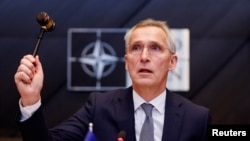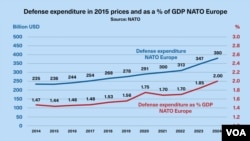This year, for the first time since the alliance’s creation, NATO’s European allies will spend 2% of their collective GDP on defense, Secretary General Jens Stoltenberg announced Thursday.
“In 2024, NATO allies in Europe will invest a combined total of $380 billion in defense,” said Stoltenberg.
Eighteen of the 31 NATO members this year will spend at least 2% of their GDP on defense, the 2024 goal set by NATO members a decade ago in response to defense concerns following Russia’s illegal annexation of Crimea, Stoltenberg added.
Brad Bowman, senior director of the Center on Military and Political Power at the Foundation for Defense of Democracies, praised the “significant and positive progress” on spending but warned that “more needs to be done.”
“Every capital neglecting its commitment and failing to meet the spending floor this year has some serious explaining to do. We are witnessing the worst invasion in Europe since World War II. What the heck are those remaining governments waiting for?” Bowman told VOA.
Poland and the United States are expected to lead NATO’s defense spending as a percentage of each countries’ GDP, while Luxembourg spends the least amount of its GDP on defense.
Stoltenberg warned member countries on Thursday against allowing a wedge to be driven between the United States and other NATO members.
Concern has spread about Washington's commitment to its allies should Donald Trump return to office, after Trump, the current Republican front-runner for president, said Saturday he once warned that he would “encourage” Russians “to do whatever the hell they want” to NATO members that are "delinquent" in devoting 2% of GDP to defense.
Democratic President Joe Biden has branded Trump's remarks "dangerous" and "un-American."
Stoltenberg on Thursday said he was confident that the U.S. would remain a “staunch ally,” because “it is in the national security interest of the United States to have a strong NATO,” and because there is still “broad bipartisan support for NATO in the United States.”
“The criticism in the United States is not primarily against NATO. It's against NATO allies not spending enough money on NATO,” he added, calling it a “fair case to raise from the U.S.” for many years.
“But things have really changed,” he said, pointing out that by the end of this year, NATO’s European allies and Canada will have added more than $600 billion to defense since the 2014 pledge.
Trump, who took office more than two years after the 2014 pledge was made in Wales, bragged on Saturday that NATO was “busted” until he came along and “got them to pay up.”
According to NATO data, the bloc’s European wing did increase collective expenditures on defense from 1.48% of GDP in 2017, Trump’s first year in office, to 1.75% in his last year, 2020. But much of that rise was the result of small annual increases in total dollar expenditures that started in 2015 and continued through 2022, even as the region's economies were shrinking during the COVID pandemic.
Spending as a percentage of GDP remained relatively flat and even fell back to 1.70% over the next two years as the countries' economies improved but shot up sharply after Russia’s invasion of Ukraine in February 2022, reaching 2%.
“Success has many parents, but Russian President Vladimir Putin deserves more credit than anyone for NATO’s growing strength and solidarity,” FDD’s Bowman said.
The North Atlantic Treaty Organization was created in 1949 to provide collective security against the Soviet Union. After Russia’s illegal annexation of Crimea in 2014, NATO’s heads of state and government agreed to spend 2% of their GDP on defense by 2024.
Stoltenberg on Thursday praised the alliance for its support of Ukraine, saying that NATO allies accounted for 99% of military aid to Kyiv.
“Since Russia's invasion, the United States has provided Ukraine with around $75 billion in military aid, financial and humanitarian aid. Other NATO allies and partners have provided over $100 billion, so our support is an example of true transatlantic burden sharing.”
The U.S. has not sent a new round of aid to Ukraine since late December, when funding ran out. The Senate passed a new bill that includes more than $60 billion for Ukraine, and that appears to have support from Democrats and some Republicans in the House of Representatives. But the legislation faces opposition from Republican leaders who currently control the House’s agenda.













